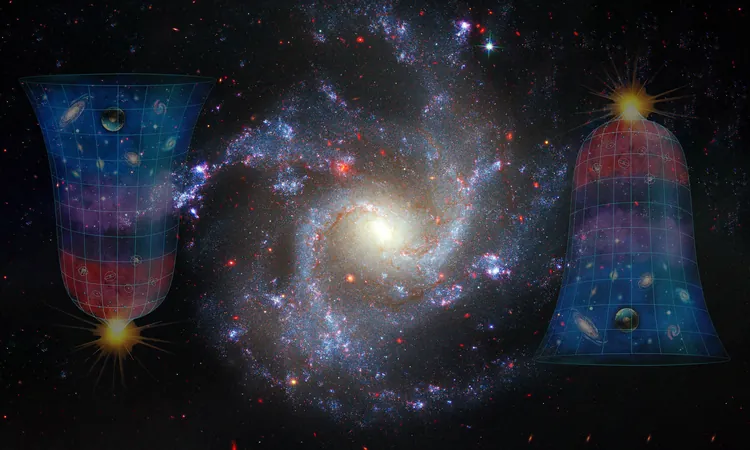
NASA's Webb Telescope Reveals Shocking Truths: Our Understanding of the Universe Might Be All Wrong!
2024-11-30
Author: Lok
For decades, scientists have been engaged in a cosmic puzzle: the mystery of how fast our universe is expanding. This fundamental question not only influences the formation of galaxies but also their eventual fate as they drift apart over time.
At the heart of this cosmic conundrum is a crucial number known as the 'Hubble constant,' which shapes our understanding of the universe's age and ultimate destiny. Yet, despite relentless efforts from some of the brightest minds in astrophysics, a recurring issue dubbed the 'Hubble tension' continues to baffle researchers.
Leading the charge on this perplexing matter is physicist Adam Riess from Johns Hopkins University, who was awarded a Nobel Prize for demonstrating that the expansion of the universe is accelerating due to mysterious dark energy. "With measurement errors ruled out, we’re left with the exciting possibility that we might simply have misunderstood the universe," Riess expressed.
The Significance of the Hubble Constant
Understanding the rate of cosmic expansion is paramount. Named after Edwin Hubble, who first noted that galaxies are moving away from each other, this constant aids in mapping the universe's history and predicting its future. The Hubble Space Telescope, launched in 1990, aimed to produce a reliable estimate of this constant, previously leading to wildly varying estimates of the universe's age, ranging from 10 to 20 billion years. Today, thanks to the Hubble's observations, we better estimate the universe's age to be around 13.8 billion years.
Can Webb Telescope Unravel the Mystery?
Some scientists have speculated that discrepancies in the measurements originated from Hubble's data itself. Enter the James Webb Space Telescope, hailed as Hubble's successor, which has provided infrared observations of Cepheid variable stars — cosmic distance markers that coincided perfectly with Hubble's optical data. "Webb and Hubble together provide a comprehensive view of the universe, validating the measurements we continue to gather," Riess affirmed.
Unanswered Questions: Hubble vs. Webb
Despite the new data, the tension remains. While Webb and Hubble agree on the expansion rate in the local universe, observations of the early universe, particularly from the Planck satellite's cosmic microwave background radiation mapping, suggest an entirely different rate. This discrepancy has cosmologists pondering whether new physics is at play or whether there's a fundamental misunderstanding about the nature of space-time itself.
An Innovative Approach by Brenda Frye
In an attempt to resolve the Hubble tension, astrophysicist Brenda Frye from the University of Arizona led a team to employ an unconventional method: measuring the Hubble constant using gravitationally lensed supernovae. This technique, independent of previous measurements, involved observing a supernova magnified by a galaxy cluster's gravitational lens. Their findings provided a Hubble constant of 75.4 kilometers per second per megaparsec, echoing measurements from the local universe while still clashing with earlier data from the youthful universe.
What’s Next?
Where does this leave us? The Hubble tension hints that we may be on the brink of groundbreaking discoveries about the cosmos. Perhaps our understanding of dark energy and dark matter requires a significant overhaul, or maybe we’re missing vital pieces of the cosmic puzzle. "We need to reassess our connection between the beginnings of the universe and present day," Riess noted.
New Theories on the Horizon
Could there be entirely new forces or particles impacting the expansion rate, or might the very fabric of dark energy be evolving? Theoretical physicists are also exploring the possibility of extra dimensions or variations in gravitational forces on grand scales. What if the universe isn’t uniform, but has intricate variations in density influencing cosmic expansion?
The Road Ahead
As we navigate this thrilling landscape of unknowns, upcoming missions like NASA's Nancy Grace Roman Space Telescope and ESA's Euclid mission are poised to provide fresh insights into these cosmic enigmas. For now, we are continually reminded that while remarkable strides in our understanding have been made, the universe is an unpredictable and enigmatic entity that holds its secrets tightly.
Stay tuned as scientists tease apart the threads of the universe, and remember, each discovery is merely a prelude to a larger mystery waiting to unfold!




 Brasil (PT)
Brasil (PT)
 Canada (EN)
Canada (EN)
 Chile (ES)
Chile (ES)
 España (ES)
España (ES)
 France (FR)
France (FR)
 Hong Kong (EN)
Hong Kong (EN)
 Italia (IT)
Italia (IT)
 日本 (JA)
日本 (JA)
 Magyarország (HU)
Magyarország (HU)
 Norge (NO)
Norge (NO)
 Polska (PL)
Polska (PL)
 Schweiz (DE)
Schweiz (DE)
 Singapore (EN)
Singapore (EN)
 Sverige (SV)
Sverige (SV)
 Suomi (FI)
Suomi (FI)
 Türkiye (TR)
Türkiye (TR)